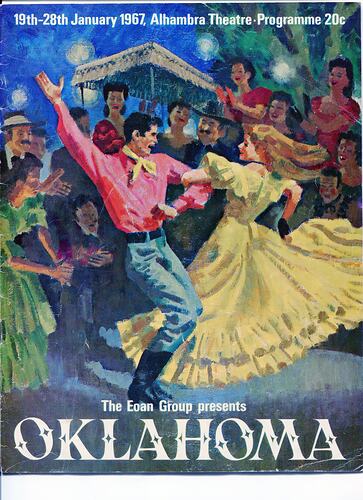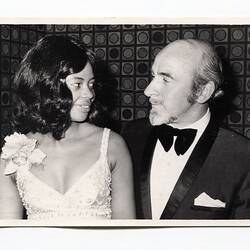Summary
Souvenir programme from the EOAN Group's performance of 'Oklahoma'. Sylvia Booysen is listed under 'Singing Chorus'. Sylvia joined the EOAN Group in 1966 and performed in a variety of operas. She met her future husband, Lindsay Motherwell, through the Eoan Group's production of 'South Pacific'. The cover states that it was performed on 19th-28th January 1967, at the Alhambra Theatre. The programme cost 20c.
Sylvia Boyes (a South African-born orphan) and Lindsay Motherwell (a Melbourne-born drummer) met in Cape Town, South Africa in 1967 through their theatre connections. They fell in love but due to apartheid laws were forced to leave South Africa to marry in London. They subsequently relocated permanently to Melbourne in 1970.
Physical Description
Inside the front page is a credits list, from the original writers to the principal actors and directors to choreography and costumes. There is a foreword from the Chairman, Mr I. Sydow, and photos and summaries are provided for Stanley Waren (director), Joseph Manca (musical director), and the principal actors. In the centre fold is a summary of characters and the actors who play them, as well as a summary of the scenes and musical numbers in both English and Afrikaans. There are group photos of the singing and dancing choruses, with their names listed on the back page credits. Advertisements appear throughout the programme, including on the back page.
Significance
Statement of Historical Significance:
This collection provides a significant opportunity to represent political and personal freedom as a motivation for migrating to Australia within the international context of both apartheid in South Africa and the end of the White Australia policy in Australia. The personal narrative is well documented and the objects provide a material way to follow the lives of both Lindsay and Sylvia, both separately and where they coincide in South Africa and onwards together to Melbourne. While this is ultimately a love story, it plays out through the collection against the backdrop of apartheid South Africa, sixties London and an increasingly multicultural Australia.
More Information
-
Collecting Areas
-
Person Named
-
Classification
-
Category
-
Discipline
-
Type of item
-
Overall Dimensions - Closed
216 mm (Width), 278 mm (Height)
-
Overall Dimensions - Open
432 mm (Width), 278 mm (Height)
-
Keywords
South African Immigration, Travel, Musicians, Jazz Bands, Immigration Policies, Apartheid, Racism, Entertainment, Operas, Performing Arts, Race Relations



